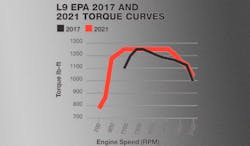Cummins tweaks 2021 L9 MD engine for lower emissions, better durability and reliability
With more than 35 years of engineering behind it, Cummins’ L9 medium-duty engine didn’t require an entire redesign this year, but the Columbus, Ind.-based engine maker did have to meet the stricter emissions requirements set forth by the Environmental Protection Agency’s 2021 Phase 2 Greenhouse Gas Emissions and Fuel Efficiency Standards. The solution was to keep the base engine for the EPA21 L9 as is, without adding and enhancing external emissions equipment, explained Adam Field, asst. product manager for Cummins on-highway engine business, at the virtual 2021 Work Truck Show.
“We set out to bolster reliability, deliver stronger performance curves, and significantly extend maintenance intervals compared to the previous offering,” Field said during the engine overview.
The engine was revealed at the in-person 2020 Work Truck Show, though Cummins could now provide more insights after further validation ad field tests.
“We're seeing fuel efficiency improvements of up to 3.5% for the Performance Series and up to 1.5% for the Productivity Series, depending on the duty cycle," Field said.
This stemmed from reducing parasitic losses and engine downspeeding.
“To improve product performance, we lowered the EPA2021 L9 peak torque speed, which provides full torque over a wide operating range and therefore improved drivability with less downshifting required on grade,” noted Derek Kiesler, medium duty on-highway product manager.
The 6-cylinder L9 features 260-380 hp, peak torque of 860-1250 lb.-ft., and weighs 1,695 lb. (dry).
The results are sure to be appreciated by Cummins customers, who in total have purchased 5 million L9 engines over its lifetime.
Other changes included reducing and optimizing the piston ring tensions and coatings, modifying the camshaft valve timing, and setting water pump speeds to optimal levels that eliminate unnecessary coolant flow.
The engine control module also received an upgrade “to enable the thousands of calculations required per second to meet emissions and run diagnostics required,” Kiesler said. “All this is done while keeping the interface to the OEMs common with the EPA 2017 product.”
The tweaks not only fulfilled the EPA requirements but also fortified the engine for severe operations.
“Internal hardware improvements were made to the turbocharger actuator, plus the addition of improved coolant venting to handle the most challenging running and hot shutdown conditions,” Kiesler said.
Because of the crankcase ventilation system redesign, crankcase breather filters no longer need to be replaced and are now considered maintenance-free for the engine’s life.
To prevent oil leaks, the oil pan rail and oil pan gasket were re-engineered for a more secure seal.
Fleets will also worry less about scheduled oil drains as well, as the oil filter and oil change intervals were synchronized to 50,000 miles/1,500 hours. The fuel filter interval was improved by a factor of three, Field said.
Cummins provided severe specific information as well: “Our severe-duty cycle is stated to be 3-4.9 mpg. The ODI at this duty cycle is 15,000 miles/1,500 hours with an oil pan size of 29 quarts or greater. For oil pan sizes below 29 quarts, the ODI is 12,500 miles/1,200 hours.”
About the Author
John Hitch
Editor
John Hitch is the editor-in-chief of Fleet Maintenance, providing maintenance management and technicians with the the latest information on the tools and strategies to keep their fleets' commercial vehicles moving. He is based out of Cleveland, Ohio, and was previously senior editor for FleetOwner. He previously wrote about manufacturing and advanced technology for IndustryWeek and New Equipment Digest.


